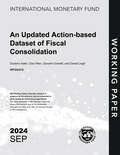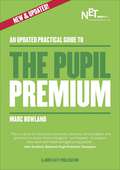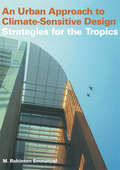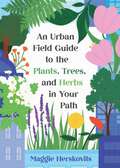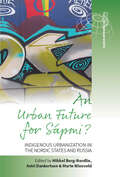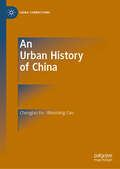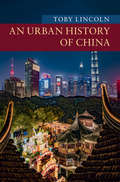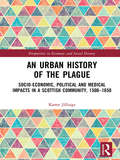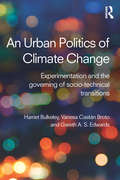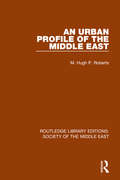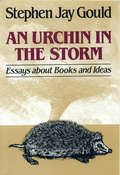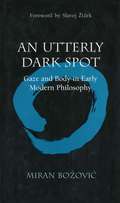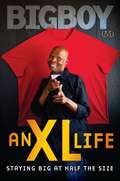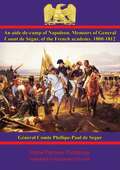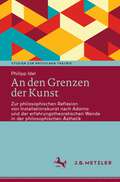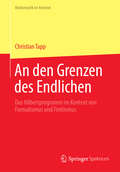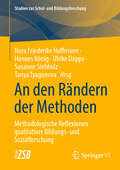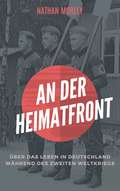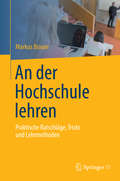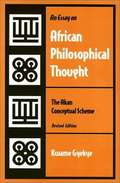- Table View
- List View
An Updated Action-based Dataset of Fiscal Consolidation
by LeighA report from the International Monetary Fund.
An Updated Measure of Poverty (Re)Drawing the Line: (re)drawing The Line
by Committee on National Statistics Division of Behavioral and Social Sciences and Education National Academies of Sciences, Engineering, and Medicine Panel on Evaluation and Improvements to the Supplemental Poverty MeasureAn accurate measure of poverty is necessary to fully understand how the economy is performing across all segments of the population and to assess the effects of government policies on communities and families. In addition, poverty statistics are essential in determining the size and composition of the population whose basic needs are going unmet and to help society target resources to address those needs. An Updated Measure of Poverty: (Re)Drawing the Line recommends updating the methodology used by the Census Bureau to calculate the Supplemental Poverty Measure (SPM) to reflect household basic needs. This report recommends that the more comprehensive SPM replace the current Official Poverty Measure as the primary statistical measure of poverty the Census Bureau uses. The report assesses the strengths and weaknesses of the SPM and provides recommendations for updating its methodology and expanding its use in recognition of the needs of most American families such as medical care, childcare, and housing costs.
An Updated Practical Guide to the Pupil Premium
by Marc RowlandFully updated with the 2015 policy updates from the Department for Education and published in partnership with the National Education Trust, this book provides essential information and advice to help schools make best use of the Pupil Premium grant and improve outcomes for disadvantaged learners. The author is a recognised national expert on the Pupil Premium. He has visited more than 200 schools and has spoken with over 1000 school leaders and here he shares examples of innovation and excellence in their use of the additional funding. Featuring a foreword by Sir John Dunford, DfE Pupil Premium Champion.
An Updated Practical Guide to the Pupil Premium
by Marc RowlandFully updated with the 2015 policy updates from the Department for Education and published in partnership with the National Education Trust, this book provides essential information and advice to help schools make best use of the Pupil Premium grant and improve outcomes for disadvantaged learners. The author is a recognised national expert on the Pupil Premium. He has visited more than 200 schools and has spoken with over 1000 school leaders and here he shares examples of innovation and excellence in their use of the additional funding. Featuring a foreword by Sir John Dunford, DfE Pupil Premium Champion.
An Urban Approach To Climate Sensitive Design: Strategies for the Tropics
by Rohinton EmmanuelThe need to respond to the rapidly changing city climate is particularly urgent in the tropics where the urban transition is currently at its peak. While the need is clearly felt by the tropical urban dwellers, texts that provide an overview of the problem and indicate possible design solutions are rare. This comprehensive reference will be welcomed by student and practising architects as well as other built envronment professionals engaged with the environmental effects of building in worldwide warm and humid climates.
An Urban Field Guide to the Plants, Trees, and Herbs in Your Path
by Maggie HerskovitsBefriend the plants in your neighborhood. Imagine going for a walk with a knowledgeable friend who points out all the plants you see and the coolest facts about them. This practical field guide is that friend, providing a delightful introduction to 57 of the plants, trees, weeds, and herbs you’ll encounter walking around most US cities. Accurate, charming line drawings accompany detailed yet accessible botanical information about each plant that helps you easily identify it in all seasons. You’ll also learn each plant's backstory, including its relatives, origins, historical uses, and other fun facts. Getting to know the plants you meet every day will help you strengthen your sense of place, improve your foraging game, make new botanical and herbal friends, and marvel at the life that is all around us.
An Urban Future for Sápmi?: Indigenous Urbanization in the Nordic States and Russia (Studies in the Circumpolar North #4)
by Marte Winsvold Mikkel Berg-Nordlie, Astri DankertsenPresenting the political and cultural processes that occur within the indigenous Sámi people of North Europe as they undergo urbanization, this book examines how they have retained their sense of history and culture in this new setting. The book presents data and analysis on subjects such as indigenous urbanization history, urban indigenous identity issues, urban indigenous youth, and the governance of urban “spaces” for indigenous culture and community. The book is written by a team of researchers, mostly Sámi, from all the countries covered in the book.
An Urban History of China (China Connections)
by Chonglan Fu Wenming CaoThis book considers urban development in China, highlighting links between China’s history and civilization and the rapid evolution of its urban forms. It explores the early days of urban dwelling in China, progressing to an analysis of residential environments in the industrial age. It also examines China’s modern and postmodern architecture, considered as derivative or lacking spiritual meaning or personality, and showcases how China's traditional culture underpins the emergence of China’s modern cities. Focusing on the notion of “courtyard spirit” in China, it offers a study of the urban public squares central to Chinese society, and examines the disruption of the traditional Square model and the rise and growth of new architectural models.
An Urban History of China (New Approaches to Asian History)
by Toby LincolnIn this accessible new study, Toby Lincoln offers the first history of Chinese cities from their origins to the present. Despite being an agricultural society for thousands of years, China had an imperial urban civilization. Over the last century, this urban civilization has been transformed into the world's largest modern urban society. Throughout their long history, Chinese cities have been shaped by interactions with those around the world, and the story of urban China is a crucial part of the history of how the world has become an urban society. Exploring the global connections of Chinese cities, the urban system, urban governance, and daily life alongside introductions to major historical debates and extracts from primary sources, this is essential reading for all those interested in China and in urban history.
An Urban History of The Plague: Socio-Economic, Political and Medical Impacts in a Scottish Community, 1500–1650 (Perspectives in Economic and Social History)
by Karen JillingsAs a medical, economic, spiritual and demographic crisis, plague affected practically every aspect of an early modern community whether on a local, regional or national scale. Its study therefore affords opportunities for the reassessment of many aspects of the pre-modern world. This book examines the incidence and effects of plague in an early modern Scottish community by analysing civic, medical and social responses to epidemics in the north-east port of Aberdeen, focusing on the period 1500–1650. While Aberdeen’s experience of plague was in many ways similar to that of other towns throughout Europe, certain idiosyncrasies in the city make it a particularly interesting case study, which challenges several assumptions about early modern mentalities.
An Urban Politics of Climate Change: Experimentation and the Governing of Socio-Technical Transitions
by Vanesa Castán Broto Harriet A Bulkeley Gareth A.S. EdwardsThe confluence of global climate change, growing levels of energy consumption and rapid urbanization has led the international policy community to regard urban responses to climate change as ‘an urgent agenda’ (World Bank 2010). The contribution of cities to rising levels of greenhouse gas emissions coupled with concerns about the vulnerability of urban places and communities to the impacts of climate change have led to a relatively recent and rapidly proliferating interest amongst both academic and policy communities in how cities might be able to respond to mitigation and adaptation. Attention has focused on the potential for municipal authorities to develop policy and plans that can address these twin issues, and the challenges of capacity, resource and politics that have been encountered. While this literature has captured some of the essential means through which the urban response to climate change is being forged, is that it has failed to take account of the multiple sites and spaces of climate change response that are emerging in cities ‘off-plan’. An Urban Politics of Climate Change provides the first account of urban responses to climate change that moves beyond the boundary of municipal institutions to critically examine the governing of climate change in the city as a matter of both public and private authority, and to engage with the ways in which this is bound up with the politics and practices of urban infrastructure. The book draws on cases from multiple cities in both developed and emerging economies to providing new insight into the potential and limitations of urban responses to climate change, as well as new conceptual direction for our understanding of the politics of environmental governance.
An Urban Profile of the Middle East
by Hugh RobertsChanges in economic and social conditions throughout the Middle East have been profound, and perhaps nowhere has this been more evident than in the field of urban development and town planning. This book, first published in 1979, provides a view of the Middle East as it undergoes transition by identifying and analysing the symptoms of change.
An Urchin in the Storm: Essays about Books and Ideas
by Stephen Jay Gould"What pleasure to see the dishonest, the inept, and the misguided deftly given their due, while praise is lavished on the deserving--for reasons well and truly stated."--Kirkus Reviews<P><P> Ranging as far as the fox and as deep as the hedgehog (the urchin of his title), Stephen Jay Gould expands on geology, biological determinism, "cardboard Darwinism," and evolutionary theory in this sparkling collection.
An Utterly Dark Spot
by Miran BozovicSlovenian philosopher Miran Bozovic's An Utterly Dark Spot examines the elusive status of the body in early modern European philosophy by examining its various encounters with the gaze. Its range is impressive, moving from the Greek philosophers and theorists of the body (Aristotle, Plato, Hippocratic medical writers) to early modern thinkers (Spinoza, Leibniz, Malebranche, Descartes, Bentham) to modern figures including Jon Elster, Lacan, Althusser, Alfred Hitchcock, Stephen J. Gould, and others. Bozovic provides startling glimpses into various foreign mentalities haunted by problems of divinity, immortality, creation, nature, and desire, provoking insights that invert familiar assumptions about the relationship between mind and body. The perspective is Lacanian, but Bozovic explores the idiosyncrasies of his material (e.g., the bodies of the Scythians, the transvestites transformed and disguised for the gaze of God; or Adam's body, which remained unseen as long as it was the only one in existence) with an attention to detail that is exceptional among Lacanian theorists. The approach makes for engaging reading, as Bozovic stages imagined encounters between leading thinkers, allowing them to converse about subjects that each explored, but in a different time and place. While its focus is on a particular problem in the history of philosophy, An Utterly Dark Spot will appeal to those interested in cultural studies, semiotics, theology, the history of religion, and political philosophy as well.
An XL Life: Staying Big at Half the Size
by Kurt AlexanderGrowing up homeless, fatherless and facing more than a few problems with gang violence and issues of self-worth, Big Boy managed to rise to the top of the hip-hop world and west-coast radio scene. For 33 years of Big Boy's life size didn't matter. As he reached the pinnacle of broadcasting he just kept piling on the pounds, and claiming award after award in radio. Right around this time he stepped on the scale and it read "510" pounds, celebrities took bets that he couldn't drop the weight. Choosing to put his career first, even when his life was on the line after opting for a radical surgical procedure, Big fought through the greatest struggle of his life. In this book the joke song-singing, crank call-making, celebrity interviewing, wise-cracking, all around hilarious, humongous black dude behind the wildly popular morning radio program Big Boy's Neighborhood shares everything he lived through and learned along the way.
An aide-de-camp of Napoleon. Memoirs of General Count de Ségur, of the French academy, 1800-1812
by Général Comte Phillipe-Paul de Ségur Comte Louis-Phillipe-Antoine-Charles de Ségur Mrs Harriette Anne Crookesley Patchett-MartinSeeing a regiment of Dragoons process through Paris in 1800, Philippe de Ségur decided to join the French cavalry at the ripe old age of 19, swiftly becoming part of Napoleon's headquarters staff. From then on, his career was to be unlike many of his contemporaries, for he was the son of a well-connected father and a protégé of Napoleon's confidante, Grand-Marshal Duroc. He saw service in all of the major Napoleonic campaigns, not just a courtier, distinguished in the crucible of the cavalry charge of Somosierra and also the battlefields of Hanau and Reims.For his service under Napoleon he was forced into retirement from the army and took to writing his memoirs and historical works. His scathing attack on Napoleon's conduct during the Russian campaign Histoire de Napoléon et de la grande armée pendant l'année 1812 provoked an uproar among Napoleonic loyalists and landed de Ségur in a duel. His further memoirs were published posthumously, a three volume account edited by his grandson, and this edited version was translated into English. Being at the hub of Napoleon's headquarters gave him the opportunity to see into most of the major events of the era and he recorded these with wit and an impressive eye for detail.These memoirs are a must for any enthusiast of the Napoleonic period.Author -- Général Comte Phillipe-Paul de Ségur, 1780-1873Editor - Comte Louis-Phillipe-Antoine-Charles de Ségur, b. 1838Translator - Mrs. Harriette Anne Crookesley Patchett-MartinText taken, whole and complete, from the edition published in New York, D. Appleton and company, 1895.Original Page Count - xxvi, 440 p.
An den Grenzen der Kunst: Zur philosophischen Reflexion von Installationskunst nach Adorno und der erfahrungstheoretischen Wende in der philosophischen Ästhetik (Studien zur Kritischen Theorie)
by Philipp IdelInstallationskunst verschiebt die Grenzen der Künste und der Kunst, indem sie die Künste füreinander und die Kunst für die außerkünstlerische Realität sowie für die Betrachterin öffnet. Das wirft nach Ansicht vieler die Frage auf, ob Installationskunst autonom ist. Die erfahrungstheoretische Ästhetik behauptet, Installationskunst als autonome Kunst begreiflich machen zu können, wodurch diese Ästhetik sich von Theodor W. Adornos Ästhetik unterscheide. Das Buch zeigt, dass das nicht zutrifft, und wie Adornos Ästhetik zur philosophischen Reflexion von Installationskunst beitragen kann.
An den Grenzen des Endlichen: Das Hilbertprogramm im Kontext von Formalismus und Finitismus (Mathematik im Kontext)
by Christian TappDer Mathematiker David Hilbert entwickelte mit seiner Beweistheorie ein Programm zur Grundlegung der Mathematik. In der ersten deutschsprachigen Monographie zum Thema bietet der Autor neue Deutungen des Hilbertprogramms. Ausgehend von den historischen Quellen stellt er die Frage neu, ob Hilbert eine formalistische Philosophie der Mathematik voraussetzte. Er macht die Fülle der Ideen sichtbar, die Hilbert und seine Schüler formulierten, diskutiert anspruchsvolle philosophische Implikationen und räumt mit einer Reihe von Fehlinterpretationen auf.
An den Rändern der Methoden: Methodologische Reflexionen qualitativer Bildungs- und Sozialforschung (Studien zur Schul- und Bildungsforschung #94)
by Susanne Siebholz Ulrike Deppe Tanya Tyagunova Hannes König Nora Friederike HoffmannErst nachdem die qualitative Forschung sich methodisiert hat, konnte sie sich in der Weise in der Sozial- und insbesondere Bildungswissenschaft etablieren, in der sie es heute ist. Welche Herausforderungen, Begrenzungen und Potenziale aber mit dieser Methodisierung verbunden sind, ist Gegenstand anhaltender Auseinandersetzungen und Reflexionen. Diese richten sich z. B. auf Fragen der Gegenstandsangemessenheit oder -adäquanz, der (Weiter-)Entwicklung und Ausdifferenzierung des Methoden-Repertoires, der Standortgebundenheit methodischer Forschung sowie der Gütekriterien des Sinnverstehens. Der Band versammelt Beiträge, die diesen Fragen gewidmet sind. Er stellt allgemeine und spezifische Probleme zur Diskussion, die mit einer sich entwickelnden qualitativen Sozial- und Bildungsforschung, die sich in Methoden vollzieht, einhergehen.
An der Heimatfront: Zu Hause während des zweiten Weltkrieges
by Nathan MorleyAn der Heimatfront bietet eine überzeugende und umfassende Darstellung des Alltagslebens in Deutschland während des zweiten Weltkrieges und zeigt auf, wie die Bevölkerung während dieser beispiellosen Notlage versucht hat, Normalität zu finden. Dieses Buch stützt sich auf eine Vielzahl von Quellen und berichtet von weltlichen bis hin zu bedeutsamen Themen wie dem Umgang mit der Rationierung, Kriminalität, Reisebeschränkungen, Bombenangriffen und der Schwankung der Zivilmoral, als sich der Krieg rasch gegen die Nazis richtet. Die offiziellen Zeitungen jener Jahre - darunter Das Reich, Völkischer Beobachter und Der Angriff – zeigen auf, wie und was die Öffentlichkeit von den Erfolgen und Misserfolgen ihrer Nation im Krieg erfuhr. Neben den umfangreichen Archiven deutscher Zeitungen, Polizeiberichten und Tagebüchern aus der Öffentlichkeit und der Politik tragen Periodenreden, private unveröffentlichte Briefe, Sendungen, Wochenschauen und Zeugenaussagen dazu bei, ein Bild vom täglichen Leben im nationalsozialistischen Deutschland zu zeichnen. Von der Reaktion auf die dramatischen Ereignisse an der Ostfront bis zu den häuslichen Schwierigkeiten beim Kochen mit synthetischen Lebensmitteln ist das Leben an der deutschen Heimatfront reichhaltig dokumentiert.
An der Hochschule lehren: Praktische Ratschläge, Tricks und Lehrmethoden
by Markus BrauerWenn es Ihnen wie den meisten Ihrer Kollegen geht, erhalten Sie als Dozent oder Doktorand keine Grundausbildung in Didaktik und Pädagogik für Ihre Hochschullehre. Es scheint als ob die Fähigkeit, Studierende zu unterrichten und sie in ihrem Lernen zu fördern, eine Selbstverständlichkeit wäre. Das ist natürlich falsch, und das Ziel dieses Buch ist es, diese Lücke zu füllen und Sie in Ihrer Lehre zu unterstützen.Forschungen über die Aufmerksamkeit, das Gedächtnis und die Motivation haben es ermöglicht, Lehrmethoden zu entwickeln, die das Verstehen und Lernen der Studierenden maximieren. Diese Lehrmethoden integrieren unter anderem das "aktive Lernen", das sich durch eine aktive Teilnahme der Studierenden am Lernprozess auszeichnet.Pragmatisch und praktisch werden in diesem Buch die didaktischen Methoden vorgestellt, die "funktionieren". Sie erfahren, wie Sie diese in großen Veranstaltungen (Vorlesungen) und kleinen Veranstaltungen (Seminare, Übungen) anwenden können. Dieses Buch enthält viele praktische und konkrete Hinweise für die Lehre, behandelt aber auch andere für Sie wichtige Themen wie Prüfungen, das "Schwätzen", die Motivation der Studierenden, und Zeitmanagement.Wenn Sie Lehrender an Universitäten oder Fachhochschulen sind, dann ist dieses Buch unentbehrlich für Sie. Aber auch jene, die in der Erwachsenenbildung tätig sind, werden die vielen pädagogischen Hinweise nützlich finden. Nach dem Lesen dieses Buches werden Sie nicht nur besser unterrichten, Sie werden auch mehr Spaß an Ihrem Beruf haben.
An die Spitze im E-Commerce: Neues Wachstum im Online-Handel durch überlegene Differenzierung
by Stefan ClausingDieses Buch ist ein wertvoller Leitfaden für Online-Händler, die in einer sich ständig verändernden Branche langfristiges Wachstum erreichen wollen. Stefan Clausing bietet dafür pragmatische Strategien an, ohne dabei zu „fancy“ zu werden. Die Welt des E-Commerce hat in den letzten Jahrzehnten eine rasante Entwicklung erlebt, die durch die SARS-CoV-2-Pandemie ihren vorläufigen Höhepunkt fand. Doch im Jahr 2022 trübte sich die Stimmung ein. Der Online-Handel wurde erstmals mit negativem Wachstum konfrontiert. Jetzt ist es an der Zeit, sich als Online-Shopbetreiber neu aufzustellen. Dieses Buch bietet eine Bestandsaufnahme und zeigt, wie Sie die Chancen nutzen und den Risiken begegnen können.Aus dem InhaltVeränderung ist die Norm: Wie Wachstum im dynamischen Umfeld des E-Commerce gelingt.Positionierung ist der Schlüssel: Vom tiefen Verständnis von Ihrer Zielgruppe zu einer überzeugenden Positionierung.Traffic und Kundenakquise: Kundengewinnung als dauerhafte Herausforderung – Übersicht der wichtigsten Instrumente, um Kunden durch den Kaufentscheidungsprozess zu führen und zu Wiederholungskäufern zu machen.Datenschutz und Marketing: Hand in Hand mit einer klugen Datenstrategie und einer ausgewogenen Budgetierung über den gesamten Conversion Funnel. Customer Relationship Management: Wie Sie anhand des Customer Lifetime Value (CLV) und Kohortenanalysen die Kundenbindung steigern.Ethik im E-Commerce: Wie das Streben nach Gewinnmaximierung nicht auf Kosten des Kundenmehrwerts geht. „An die Spitze im E-Commerce“ bietet eine ganzheitliche Perspektive auf die Herausforderungen und Chancen im digitalen Handel – sowohl für große Online-Shops als auch für KMUs und Selbständige. Die ausgewogenen Ansätze und praktischen Erkenntnisse machen dieses Buch zu einem klugen Ratgeber für Online-Verkäufer, die nachhaltig wachsen und langfristig erfolgreich sein möchten.
An essay on African philosophical thought The Akan conceptual scheme (Revised edition)
by Kwame GyekyeDefining the main principles of a distinct African philosophy, this work rejects the idea that an African philosophy consists simply of the work of Africans writing on philosophy. It argues that critical analyses of specific traditional African modes of thought are necessary to develop a distinctively African philosophy.
An introduction to Confucianism
by Xinzhong YaoTaking into account the long history and wide range of Confucian Studies, this book introduces Confucianism - initiated in China by Confucius (551 BC–479 BC) - primarily as a philosophical and religious tradition. It pays attention to Confucianism in both the West and the East, focussing on the tradition's doctrines, schools, rituals, sacred places and terminology, but also stressing the adaptations, transformations and new thinking taking place in modern times. Xinzhong Yao presents Confucianism as a tradition with many dimensions and as an ancient tradition with contemporary appeal. This gives the reader a richer and clearer view of how Confucianism functioned in the past and of what it means in the present. A Chinese scholar based in the West, he draws together the many strands of Confucianism in a style accessible to students, teachers, and general readers interested in one of the world's major religious traditions.
